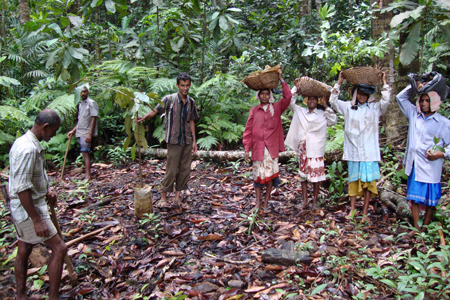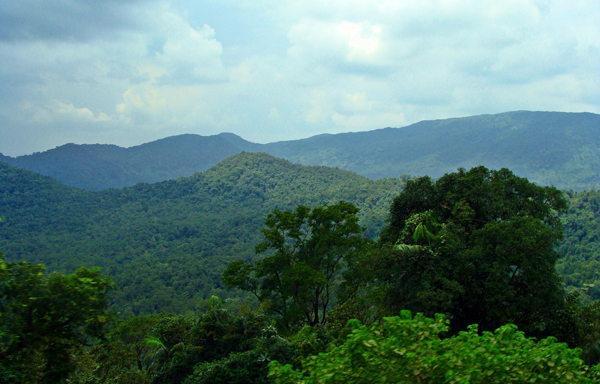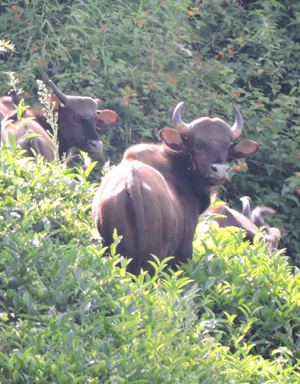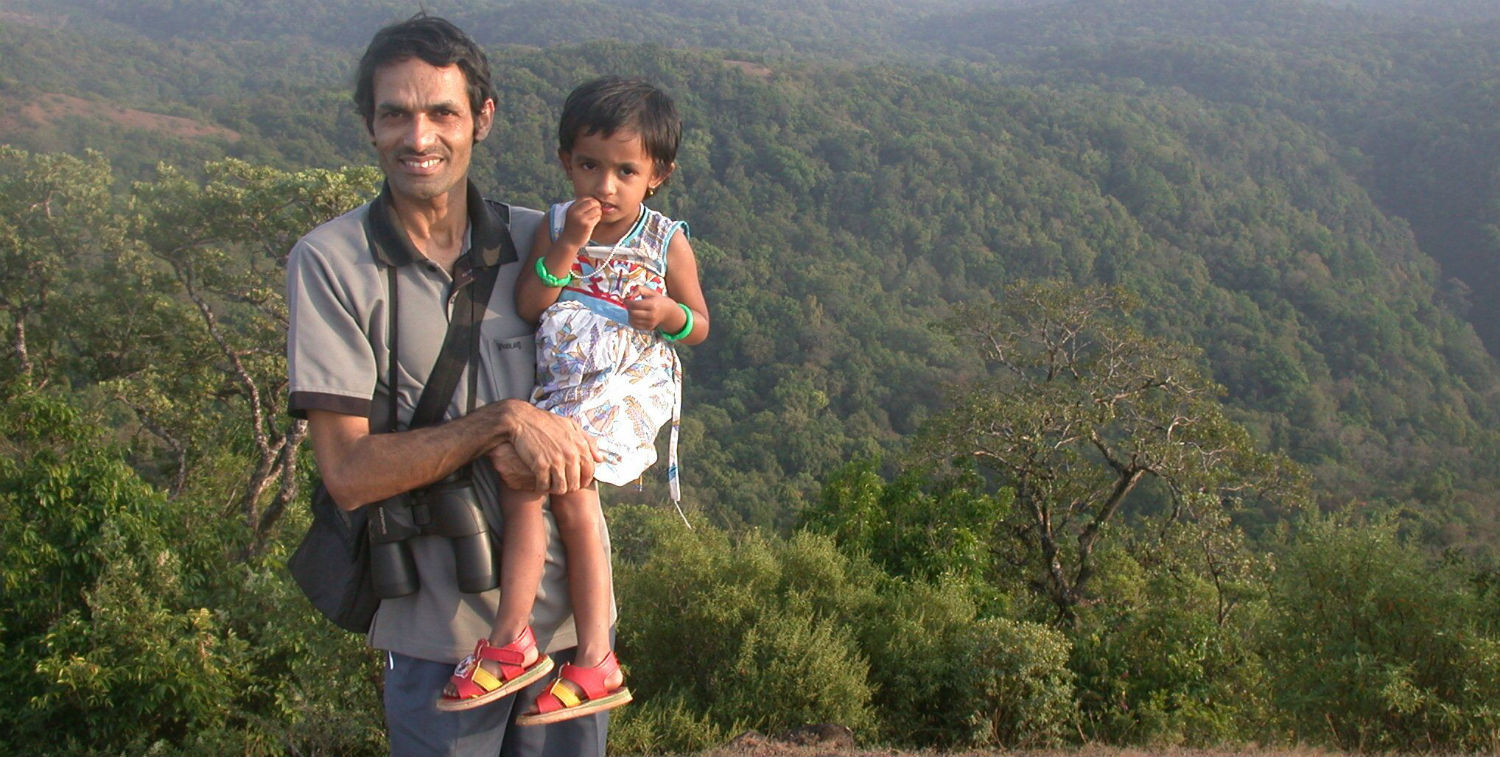
Conservation and the Sustainable Development Goals
CEPF grantees take action for a fruitful future in the Western Ghats of India
06 November 2017
Overview
People, planet, prosperity, peace and partnership — these are the areas of critical importance identified by the United Nations via the Sustainable Development Goals, also known as the SDGs or “global goals.” The Critical Ecosystem Partnership Fund (CEPF) focuses on biodiversity conservation and partnership, believing these to be fundamental to all of these elements of a sustainable future.
CEPF is a joint initiative of l'Agence Française de Développement, Conservation International, the European Union, the Global Environment Facility, the Government of Japan, the MacArthur Foundation and the World Bank. The partnership seeks to protect biodiversity hotspots — Earth’s most biologically rich yet threatened areas — by supporting nongovernmental organizations and communities in the hotspots to sustainably manage the ecosystems they depend on. Since its inception in 2000, CEPF has provided more than $185 million in grants to nearly 2,000 nongovernmental organizations and individuals to implement conservation strategies in more than 90 developing and transitional countries and territories. CEPF and its grantees help governments meet targets related to the U.N.’s Convention on Biological Diversity, Framework Convention on Climate Change and the SDGs.
In September 2015, 193 countries formally adopted the 2030 Agenda for Sustainable Development, which consists of 17 SDGs.
While CEPF-funded projects are multifaceted and support many of the SDGs, all CEPF projects directly contribute to the achievement of SDG Goal 15, which aims to “protect, restore and promote sustainable use of terrestrial ecosystems, sustainably manage forests, combat desertification, and halt and reverse land degradation and halt biodiversity loss.”
“The [2030 Agenda for Sustainable Development] document makes a clear connection between poverty eradication, solutions to climate change and conservation of ecosystems and biodiversity,” said CEPF Executive Director Olivier Langrand. “It also reveals the need for the proven CEPF mechanism to be part of the achievement of the Sustainable Development Goals.”
This connection can be clearly demonstrated through CEPF’s investment in the Western Ghats Region of India, which consists of five Indian states: Kerala, Tamil Nadu, Karnataka, Maharashtra and Goa. As part of the Western Ghats and Sri Lanka biodiversity hotspot, the Western Ghats is extraordinarily rich in species found nowhere else, but it is also one of the most densely populated of the 35 global biodiversity hotspots. This population pressure has negatively impacted the Western Ghats’ ecosystems and their life-sustaining benefits, including clean air, fresh water and healthy soils. Low per capita income coupled with high population density makes local communities particularly dependent on their ecosystems for livelihoods and basic needs, such as food and water.
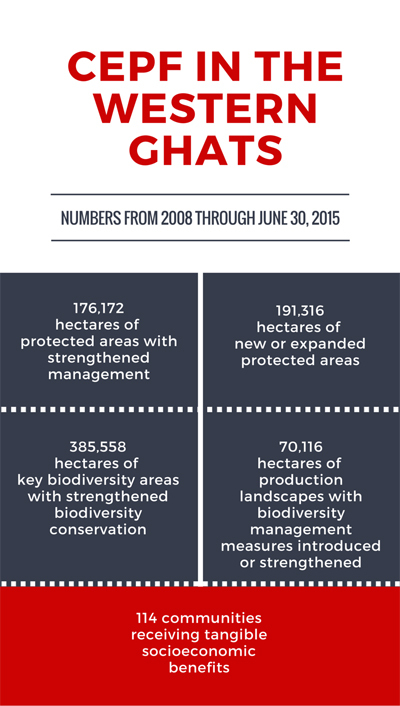
From 2008 to 2015, CEPF invested $6 million in the Western Ghats to achieve two goals:
- Enable action by diverse communities and partnerships to ensure conservation of key biodiversity areas and enhance connectivity in five corridors.
- Improve the conservation of globally threatened species through systematic conservation planning and action.
The funds supported 108 projects and 56 civil society organizations. One example of results achieved is the adoption of sustainable agricultural practices by 34 tea and coffee estates covering more than 19,000 hectares of land, as well as commitments from major international brands to source supplies from Rainforest Alliance Certified farms in the region.
CEPF also successfully facilitated networking among conservationists in the Western Ghats, bringing together people from different states and disciplines.
Follow us as we spotlight some of the people (and local organizations) who are at the heart of conservation in the Western Ghats.
People
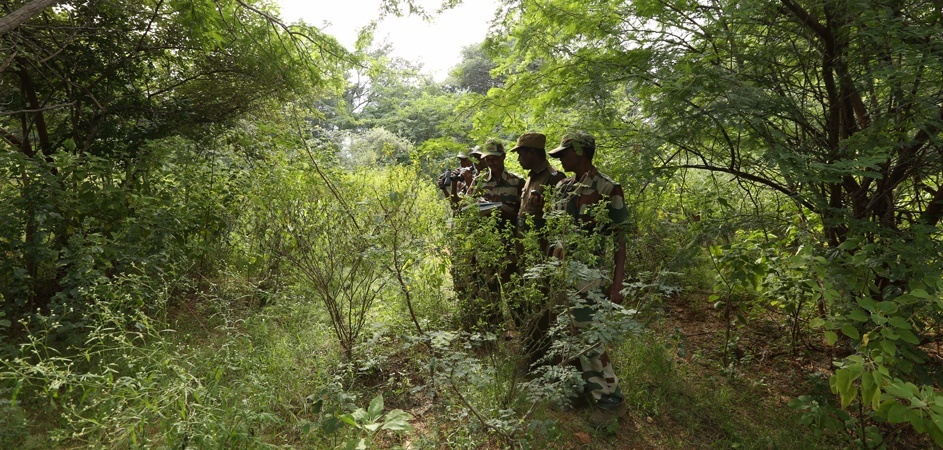
Investing in the planet begins by investing in people. CEPF understands this and supported the Care Earth Trust, in partnership with Arulagam, to build people’s capacity to conserve the River Moyar.
Coursing through Nilgiris District, the River Moyar supports Tamil Nadu’s single largest population of the Vulnerable marsh crocodile (Crocodylus palustris) and three species of Critically Endangered vultures, and functions as a corridor for Endangered Asian elephants (Elephas maximus), Endangered tigers (Panthera tigris) and other large mammals. Hydroelectric projects, pollution, tourist resorts, encroaching agriculture and other threats are degrading the River Moyar and its surrounding forests.
Care Earth Trust and Arulagam worked with local communities along the River Moyar to complete participatory socioeconomic assessments, biodiversity training and capacity building in order to develop community “micro-plans” for conservation action that incorporated biodiversity values into local development planning.
“Unless local communities are involved, conservation action is impossible in this country,” said Jayshree Vencatesen, managing trustee at Care Earth Trust. “Despite the best design, and despite your best intentions, things can be totally derailed if local people are not with you.”
According to Jayshree, this project was the first time that people were able to participate in developing plans for conserving the river.
Three micro-plans were created and endorsed by the respective Panchayats (local community self-government bodies). These micro-plans contain the most comprehensive data collected to date on the social and ecological aspects of the region.
The micro-plans also identified a set of conservation actions, two of which have already been put in place: development of the Moyar Conservation Brigade and Vulture Watchers, groups of volunteers who will undertake future biodiversity monitoring, pollution checks and removal of invasive species; and creation of a Community Conservation Learning Centre. The full list of results for the project is available via the project final report.
Since the Panchayats involved have already incorporated the micro-plans into their own five-year agendas and budgets, sustainability of the project is ensured, and co-financing processes are already in place.
This model can be replicated for future riparian projects and climate adaptation work, since riparian zones help protect species from extreme temperatures.
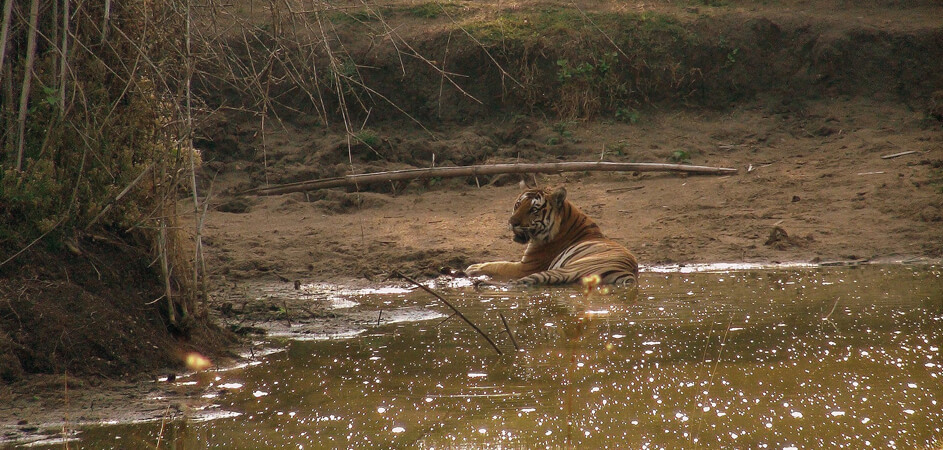
Partnership
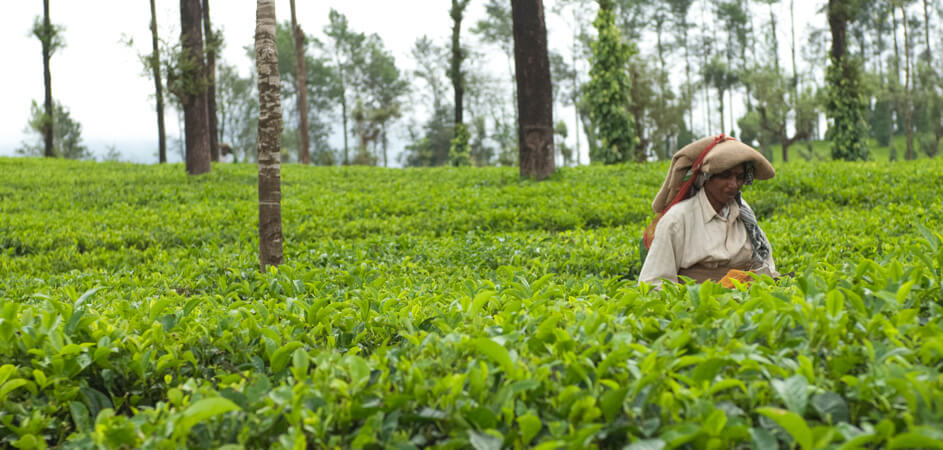
Connecting People
Local communities in the Western Ghats, especially those living in or near key biodiversity areas (KBAs), can act as guardians of the environment. Bringing these communities together can be a critical component of successful conservation.
With support from CEPF, the Wildlife Information Liaison Development Society (WILD), in partnership with the Nityata Foundation, connected motivated individuals and civil society organizations in Karnataka’s Udupi and Shimoga communities to create a network for conservation. These people live at the forest edge, in immediate proximity of conservation threats, such as destructive development and poaching.
“Through this project we have identified many key stakeholders who are actively working in conservation in the local areas,” said Anup Prakash, project manager with WILD. “We have gotten them to talk to each other through various approaches like holding regular meetings between them and the local forest department officials, and especially through using locally available technology, like the internet and smart phones, to try and collect relevant data in the region and pass it on to different stakeholders who can then use it to make decisions for positive action.”
WILD and Nityata provided communities with training to increase awareness about the importance of conservation and build capacity to protect their environment. The project engaged students and youth in nature clubs to identify and report threats in the region, and introduced sustainable technological solutions, including mobile phone applications, to encourage the sharing of information.
In addition to allowing individuals to network, this project empowered local populations to safeguard their natural resources, as well as species found only in the Western Ghats.
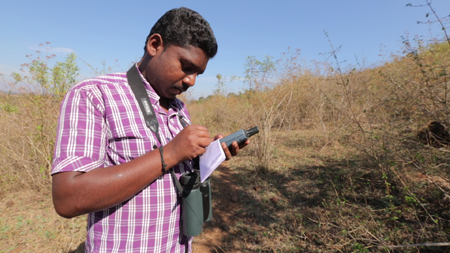
Conservation education
Raising awareness and disseminating biodiversity conservation information to local communities is a challenge in India, where the variety of languages spoken is a major barrier to communication. Without raising awareness about the importance of conservation, and engaging local communities, governing bodies and other stakeholders, conservationists cannot be successful.
Over the course of five years, CEPF supported WILD, the local partner for a CEPF grant to International Union for Conservation of Nature (IUCN), to assess the global status of 292 reptile species found in the Western Ghats. As a follow-up to this project, CEPF provided WILD with additional funding to create momentum for the conservation of globally threatened reptiles and freshwater species among local stakeholders and policymakers through education, training and follow-up of assessment projects.
“Our objective was to disseminate the information to the people who live in the Western Ghats Region,” said B.A. Daniel, a scientist with WILD. “We have a big problem with language barriers, where the communication is almost not happening, especially with regard to the transformation of the scientific information to the local community.”
A variety of local-language education materials were developed, including a teaching guide on freshwater biodiversity and reptiles, packet materials (booklet, placard, sticker, friendship band and masks), species posters and pocket field guides. Many of the education materials developed are available online here.
WILD also created a partnership among local educators and environmental journalists, and this network will continue to promote freshwater and reptile conservation. Altogether, more than 650 people were trained in a series of education and awareness programs, reaching more than 10,000 people on the ground. Read about all of the project results here.
As demonstrated in these two projects, bringing partners together and disseminating information to all stakeholders can create a momentum for conservation. This allows outreach to continue beyond the end date of a project, helping ensure long-term conservation sustainability.

Inseparable: Biodiversity & People
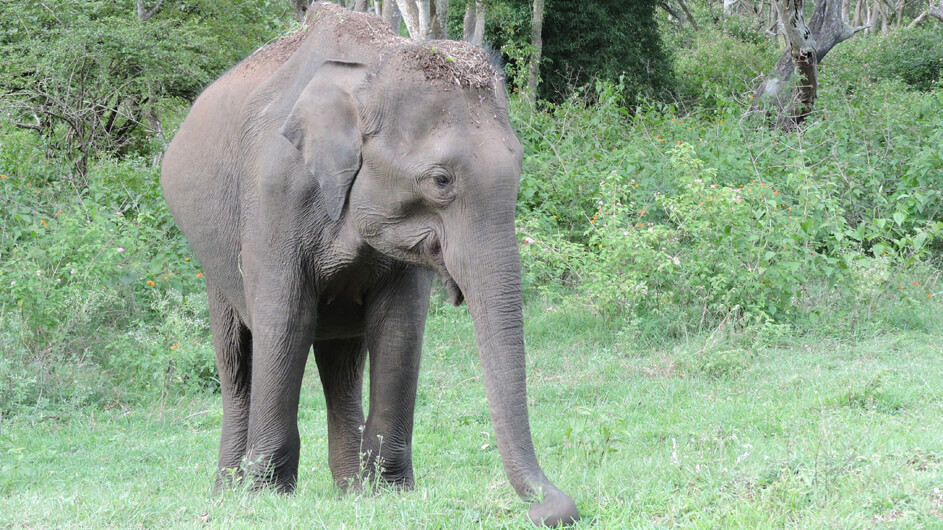
Reducing human-wildlife conflict
The Western Ghats Region is home to a quarter of India’s wildlife, but development, agriculture and urbanization are encroaching on the habitats needed to support these species. CEPF has supported efforts to improve the conservation of threatened species, taking into account the needs of local communities since an intricate relationship exists between people and biodiversity.
In the Nilgiris District Gudalur Forest Division there are a considerable number of Endangered Asian elephants. Here, human-elephant conflict continues to increase. In response, CEPF grantees The Shola Trust and Nature Conservation Foundation experimented with a range of site-specific interventions to facilitate long-term human-elephant coexistence.
To analyze local community members’ perception and “tolerance” of elephants, 300 families from Gudalur were interviewed. A key takeaway was the significant difference that exists between communities, with Kattunayakans, a hunter-gatherer tribe, being the most tolerant, and Malayalis, a new immigrant group from neighboring Kerala State, being the least tolerant.
Twenty-five family-owned tea estates were also interviewed, with encouraging results: 22 of the 25 estates were happy to have elephants on their land and were willing to actively work towards this goal.
Maps of conflict hotspots, which indicate where elephants are present, were created and disseminated to local officials and landowners. GIS-based maps were also produced for five villages and five family-owned tea estates. These demonstrate that elephant use of the Gudalur landscape is much more widespread than previously imagined, making the entire region a conflict hotspot. A full report on the project outcomes can be found online here.
“The ability for people and animals to share space is going to be a key issue for saving large mammal populations in much of the Western Ghats and possibly the rest of India as well,” said Tarsh Thekaekara, project manager and biodiversity conservationist with The Shola Trust. “All of the human-elephant mitigation strategies are currently very top-down. If you allow for more autonomy and allow local people to have their traditional mitigation strategies moving upward into policy, which is what we are trying to do in this project, that will go a long way in having more effective human-elephant conflict mitigation strategies in the years to come.”
This work is being replicated in Karnataka’s Kodagu District, and can be applied in other human-elephant coexistence areas.
In nearby Lokkere Reserve Forest, which borders Bandipur Tiger Reserve, human-wildlife conflict is also increasing as lantana (Lantana camara), a perennial flowering plant not native to India, and aggressive invasive species, prevents native vegetation from growing. This leads to a food shortage for wild animals, which in turn invade nearby villages.
With support from CEPF, the Paadhai Trust and Junglescapes partnered together to combine removal of lantana with the restoration of cleared areas using a green economy model that involves local communities. Development of a market-linked alternative livelihood option based on lantana craft items is allowing local people to earn up to about $60 USD per person per month.
“Involving local communities in any kind of habitat restoration is very critical because these are the people who are in the best position to conserve and protect the forests that are approximate to them,” said Ramesh Venkataraman from Junglescapes. “And an activity like restoration gives them employment for a fairly continuous period of time.”
Participating community members were trained to remove lantana using a cut rootstock method (which eliminates the reproductive ability of the plant), and were compensated for their help with restoration activities, including the digging of rainwater trenches, planting of saplings, etc. The community members are currently restoring a 200-hectare (494 acres) plot, receiving approximately $200 per acre.
These projects, and other CEPF-supported work in the Western Ghats, demonstrate how conservation is a social process for and by people. They also help showcase the importance of involving local people in biodiversity conservation, and strengthening cultural and economic ties to nature.
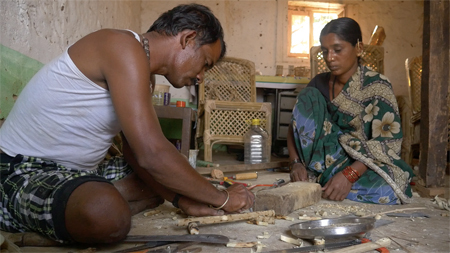
Sustaining Conservation Solutions
CEPF supports the SDGs and the United Nations recognition that sustaining a healthy environment is vital to the long-term well-being of people. While the core business of CEPF supports Goal 15, the conservation of biodiversity assists in achieving many of the SDGs.
| No. | Sustainable Developmental Goal | Results from CEPF Portfolio in the Western Ghats |
| 1 | End poverty in all its forms everywhere | 114 communities with direct socioeconomic benefits, in terms of increased income, food security or other measures of human well-being. A greater but unquantified number with indirect benefits through conservation and restoration of natural ecosystems that deliver essential provisioning and regulating services. |
| 6 | Ensure access to water and sanitation for all | Ecological connectivity restored in three clusters of Myristica swamps, ensuring delivery of fresh water essential to human well-being. Hydrological services assessment undertaken for the Coonor River, and payment for ecosystem service model under development to increase access to water for domestic use and agriculture. |
| 10 | Reduce inequality within and among countries | Indigenous communities supported to take advantage of provisions under the Forest Rights Act to secure stronger legal recognition of their traditional rights to land and forest resources; indigenous communities engaged in development of sustainable harvesting of non-timber forest products within community forest resource use areas; sacred groves restored and recognition of indigenous communities’ rights of access and management promoted. |
| 12 | Ensure sustainable consumption and production patterns | Financial incentives for the conservation and sustainable use of biodiversity on private lands piloted in three states, following different models, including negotiated individual agreements, community agreements and conservation actions. Sustainable agricultural practices adopted by 34 tea and coffee estates, covering more than 19,000 hectares, and similar measures being explored by rubber estates. |
| 15 | Sustainably manage forests, combat desertification, halt and reverse land degradation, halt biodiversity loss | 191,316 hectares of terrestrial and freshwater habitats afforded protection through the creation and expansion of protected areas, including community co-managed conservation reserves as well as conventional, government-managed protected areas. |
| 16 | Promote just, peaceful and inclusive societies | Legal support and advice provided to local communities in more than 50 cases of actual or potential ecological damage arising from development projects in the mining, transport and energy sectors. |
| 17 | Revitalize the global partnership for sustainable development | Seven global donors came together in an innovative partnership to deliver development assistance effectively, by empowering local actors to engage in sustainable development actions that deliver global and local benefits. |
As demonstrated in the Western Ghats, CEPF recognized the important role that people have as custodians of the region’s unique ecosystems. To sustain the CEPF-supported efforts to conserve the irreplaceable Western Ghats, people in the region will need to continue mobilizing resources, involving all stakeholders, and assisting the government to make a significant difference to biodiversity and ecosystem conservation.
Related Content
Find out more about CEPF and the SDGs
Watch a video series about CEPF grantees in the Western Ghats
Read a blog showcasing regional perspectives on conservation in the Western Ghats
